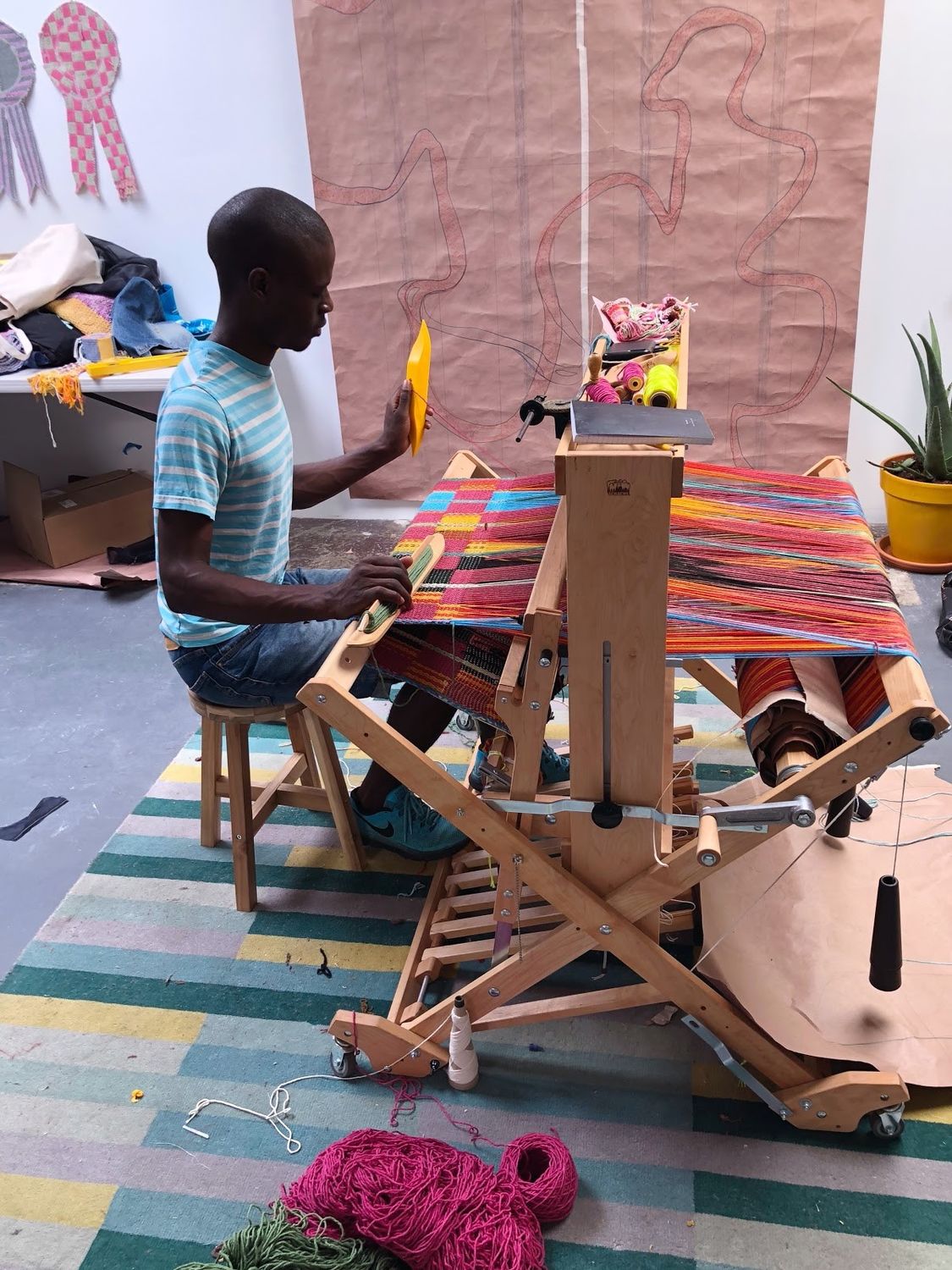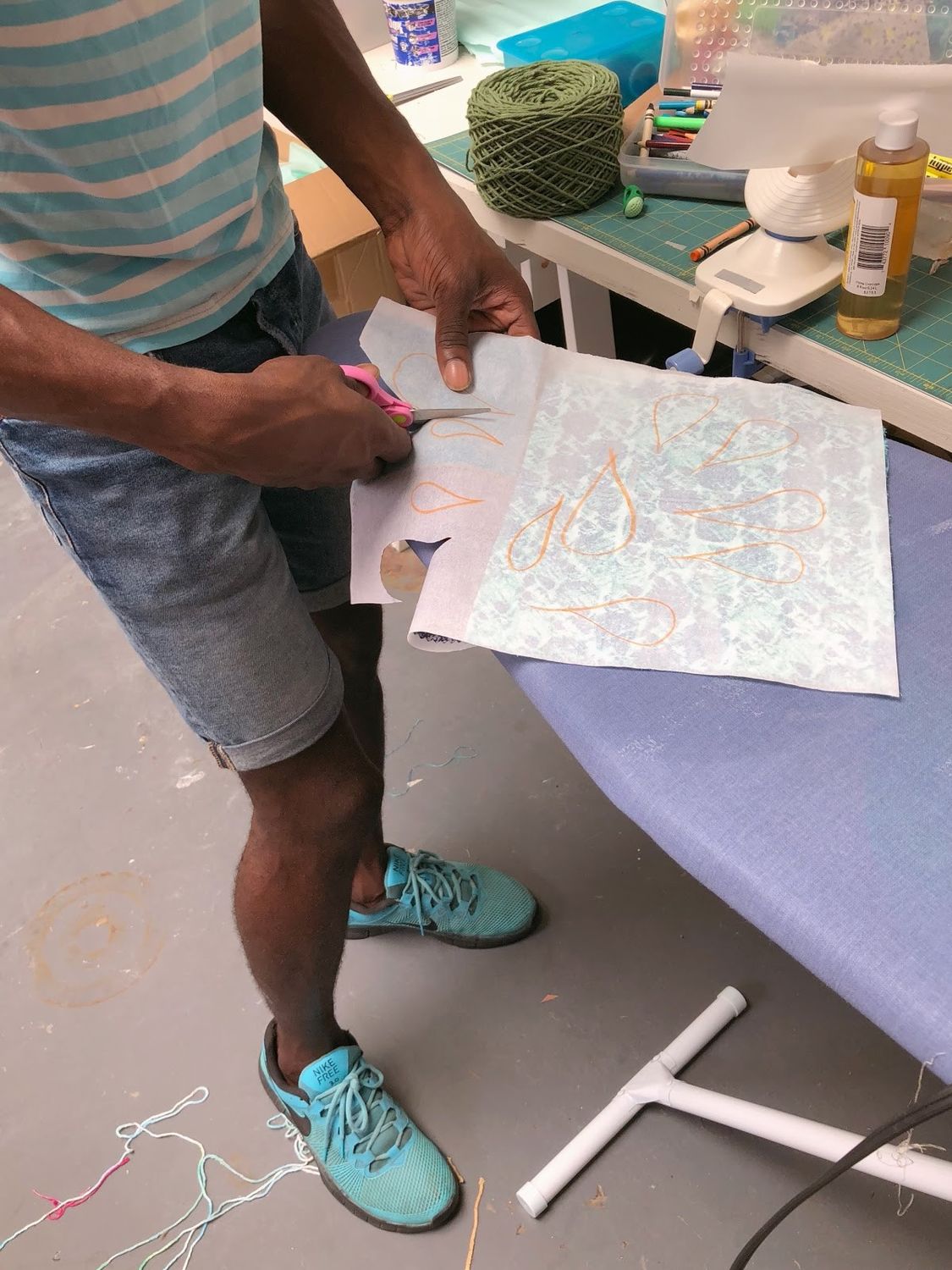
Interview with Family Day Artist Diedrick Brackens
Diedrick Brackens is an L.A.-based artist from Mexia, Texas. Diedrick’s work was recently on view in the Hammer’s Made in L.A. 2018 exhibition. He will be one of six artists leading a workshop at the Hammer’s Family Day on September 8, 2018.
Brackens uses the language of weaving and textiles to explore the intersections of identity and sociopolitical issues in the United States.
What makes weaving a compelling medium to you?
Weaving is a process-oriented medium, and the act of weaving is very meditative; you can get lost in the repetition. And weaving is very formulaic; once you know the basics, you can continue to do it without a lot of instruction. I also fell in love with the color and fiber possibilities—it’s endlessly new and exciting to me. I am also interested in the long history of weaving. Folks weave on every continent, so there are all these different possibilities, stories, and textile traditions that I get to learn about, explore, and be inspired by.
The weaving tradition that has most impacted my work and life is the strip weaving tradition from West Africa. I am particularly interested in kente cloth, which originated in Ghana but has become a cultural export that describes the black diaspora. Black folks on many continents wear kente cloth to be connected to African ancestry. In a lot of communities that I have lived in I would see folks wearing this fabric. When I became a weaver, I wanted to continue to reference and be in conversation with the cloth that has been a huge part of the communities I come from.

I’m interested in a lot of themes having to do with healing, caretaking, and domestic space, especially as those things relate to my identities, and particularly as a black man in America. I think that constructing works around positivity and healing are especially important at a time where there's a lot of attention to violence and death. For me, using cotton as my material is also really important. I want to flip the narrative of cotton, which is a crop and material that has historically been contested, violent, and a means to subjugate people. I flip this narrative by making beautiful, pleasurable objects out of the material.
I'm really interested in European tapestries. They are these lush ornate images made with silver, gold, and hundreds of textile dyes. But the images are not the main story being told. Underneath the iconography is this propaganda for Christianity, wealth, and violence. Along similar lines, I want my weavings to draw people in through textures and color so that they are compelled to spend time unpacking the darker undertones of the work. I'm always thinking about these particular moments in time and trying to do them justice by reflecting them with dignity and honor. There's always a sense of melancholy in my work, because I don't want to sugar coat these moments. I want my work to be beautiful, but I also want it to be the truth.

Brackens’s tapestry bitter attendance, down jubilee (center) is based on a real-life event near his home town before he was born. Three young black men were arrested for possession of marijuana and loaded onto a boat by the police. The boat capsized and the handcuffed men drowned. The police were brought to trial but acquitted, and the tragic event has had a lasting effect on the community.
Could you talk a little bit about your process?
I always think about the story I want to tell and the characters I will use to tell it. I photograph myself or other things in the world and make these composite images digitally. Then I make a 1:1 scale drawing. I've been looking recently at images from protests and rallies in the last three years, specifically those about from the Black Lives Matter movement and the Dakota Access Pipeline. I've also been looking at American folk tales, thinking about how the human world interacts with the natural world, and how animals tell us about ourselves. This is where I came to having animals interact with people in my weavings; I use them to think about what violence and death look like instead of imparting those things on the human figure.
There's a lot of translation that has to happen from drawing to threads. I was taught a lot of different weaving techniques independent of each other, and I combine techniques in untraditional ways. I’m interested in the larger implications of combining, for example, an African weaving technique with a European one. The fabrics themselves become hybrids of multiple traditions on multiple levels. This mixture of traditions is what American culture is. Being black in America actually means to be African and European American. They are the forces that actually brought us to the continent and run in our blood. So to make a textile with these fusions is a natural progression.

I notice your work in Made in L.A. is figurative, while some of your other work tends towards abstraction. Is there a distinction between your figurative and abstract weavings?
Abstraction is a default for the loom, so I started making figurative weavings because it was not as natural or easy to do. My work has always been reminiscent of the body even when it was abstract, but it has felt increasingly important lately to be more explicit about what my work stands for. It was challenging thinking about the Charlottesville rally last year and knowing, there are people marching in the streets who hold beliefs which endanger my life.
My work in Made in L.A. talks about historical moments in the South. They have parallels with what’s happening now around police brutality, black death, and these sentiments that people don't belong here. There are all these arbitrary boundaries based on the body that people are trying to maintain. With a completely abstract weaving, the viewer might miss the ideas about healing or violence. When there is a figure, it's harder to look around those ideas. Having actual bodies in my weavings seems like the only answer.





